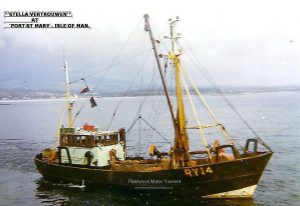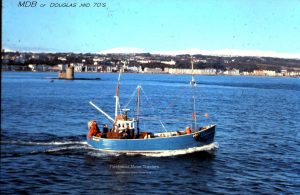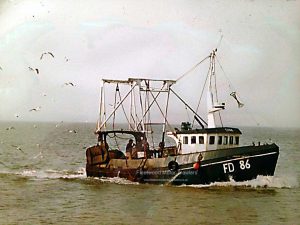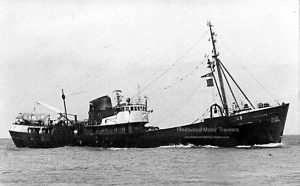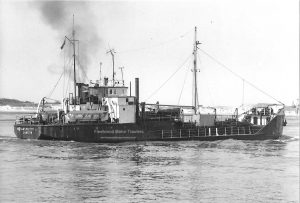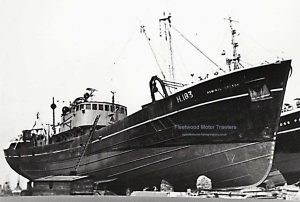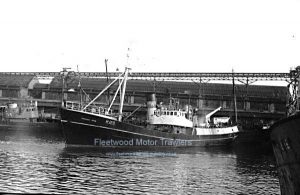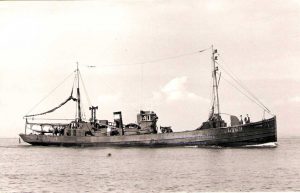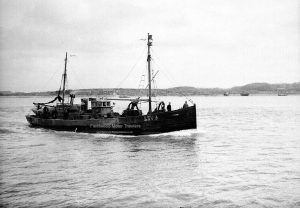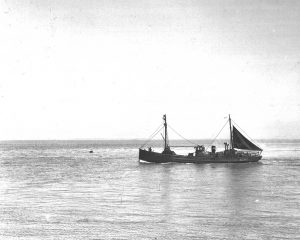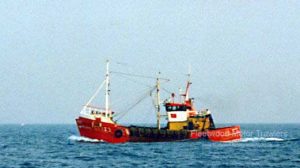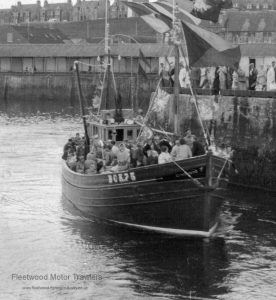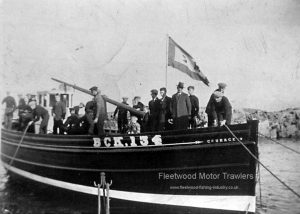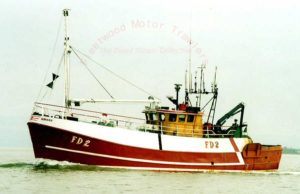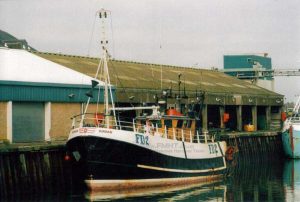Information courtesy of Dick Massey
Technical
Part IV registered
Completed: 1947
Gross Tonnage: 40
Net Tonnage: 40
Length: 54 ft
Breadth: 18 ft
Depth: 6 ft
Built: Fairlie Yacht Slip 1947
Engine: 6-cyl 150bhp 6L3B oil engine by Gardener Engines Ltd, Patricroft, Eccles, Manchester.
History
1947: Completed by Fairlie Yacht slip Ltd, Fairlie for John Andrews & others, Maidens as MAY QUEEN. Registered at Ballentrae (BA305).
MAY QUEEN BA305 Subsequently believed to have been registered/renamed as follows..
1969 CRYSTAL SEA FR340.
CRYSTAL SEA RY64
1977: CRYSTAL FD130
CRYSTAL RY24
CRYSTAL FD(?)
Undated: Beached at Fleetwood and burned out.
Notes by Dick Massey
Fishing Vessel “Crystal Sea”
Built as a Ring Netter on the Clyde,
54 feet long x 18 ft beam with a draft of 6 feet,
Engine 6L3B Gardner rated at 150 Hp with a 2/1 reduction box
Fitted to the engine an array of Gilkes Bilge and deck wash pumps.
On deck, Raised forward deck over the fo’csle cabin, then flush deck to the stern, Bulwarks, very low, being only a few inches high on the fore deck and eight inches around the rest of the deck,
The Wheel house in Ring netter Style was off set to port, this gave a wide clear working deck to starboard,
The Boats layout was from forward a large forward cabin with eight bunks, a large table with bench type seating, a large opening sky light over the table, the Galley area was in a closed of section about four foot wide at the after end, this was the full width of the boat, part of this space contained a large fresh water tank and net store,
Access to the cabin was via a low sliding hatch and vertical ladder,
The fish room, very large, with multiple pounds each side each fitted,
With a iron Bunker lid, this was to allow the Herring to be flowed off the deck under control in to the fish room, as the boat was designed to catch Herring and many tons of them, the fish room deck was fully concreted
With a large bilge well both forward and aft,
The fish room was served by a large 8 x 6 feet hatchway,
This was for the easy discharge of the catch,
With the decline of the west coast Herring Fishery, Crystal Sea was converted to be come a trawler ,working the gear over the stern,
For several years she worked the west coast of Scotland and the Minch area, the owners being all crew members, from Fraserburgh,
Bought By Dick Massey and moved to the Irish Sea, registered in Ramsey Isle of man RY64 and worked the Irish sea, and landing to ports of Fleetwood , Douglas , Peel, & Port Penryn in North Wales.
The crew at this time were Dick Massey skipper owner,
With Paul Childers of Fleetwood and Michel Leadley of Peel.
Later the boat was sold to Fleetwood shore owner, a Mr Portious with a shore manager. The name of the boat when registered in Fleetwood was changed to “CRYSTAL”
Her days ended on the beach near the Fleetwood Pier,
For reasons now unknown she was fully burnt out with only the Keel and the Gardner engine to be seen,
This class of Ring Netter were built for a special job, and this they did well, built to carry a full load of Herring 20 plus tons, the Hull was of Larch on Oak frames, with a fine entry forward and canoe stern,
The Gardner could push her along at an easy eight knots, at 900 Rpm
Buying the “CRYSTAL SEA” from Fraserburgh,,,,
James, the same who man had sold me some dredges he did not own when I was fitting out the ‘VERBENA’ to go scalloping. Now he said he wanted to make amends for his previous error, he knew where there was a good boat for sale in Scotland, he would show me where it was and come back as crew for one hundred pounds, I was to pay expenses.
If we got to Fraserburgh and the boat was no good he got his fare home and that was all. After a couple of phone calls to the fishermen’s co-op there the answer was ‘yes, she is a good boat and still for sale after the last deal fell through, somebody from the Isle of Man was going to buy her but…..’
To get to Fraserburgh from the Island was a bit awkward, by air it could be done in one day, otherwise two days or more. We flew from the Island to Glasgow, then on to Aberdeen, thence by bus to Fraserburgh. Arriving after dark I booked us in to a B & B for one night. If the boat was no good James would get his fare home.
After an early breakfast we were down at the harbour and there was the CRYSTAL SEA, fifty four feet long, an ex-ring netter from the Clyde, fully rigged and ready to go fishing.
I received permission from the Co-op manager to go aboard, and she looked good – James had disappeared after I went into the Co-op office.
The boat was eighteen feet beam with big forecastle accommodation for eight, the engine room was clean, the Gardner 150 hp engine had all its copper pipes polished, my feeling was ‘yes, I will buy her’ for three thousand pounds.
In Scotland it was not uncommon for a boat to have multiple owners, each having a part share, with the boat divided into sixty four shares. The local fish selling agent owned the biggest share, so he organised the contract, then until the weekend when the other owners returned from the west coast where they were fishing I had from memory three days to wait, then with the deposit paid I was allowed to move on board.
Still no sign of James until after dark he turned up, I had no idea what he had been up to, all he wanted to know was, was I going to buy? When I told him the deposit was paid he asked for half of the agreed one hundred, on me giving him fifty pounds he was gone, and that was the last I expected to see of him.
On the second day I started off with flu – that night after dark James came back – ‘has anybody been looking for him?’ – it sounded like trouble knowing his history as a con man. I was in my bunk dead to the world with flu, then the fo’csle hatch opened and down came three men, one very old man who it turned out was blind, another James, called Tait, a common name in Fraserborough.
When I asked what they wanted he turned in my direction, asking if this was the buyer of this fine boat? When told ‘yes’ he asked what James had to do with the boat. I told him James told me about the boat, and was to get one hundred pounds for the trip home, plus his food. By now I was feeling a very strange atmosphere in the cabin, something more than the ‘flu strangeness, and something seemed wrong, possibly James had pulled a fast one on him in the past.
With the three on the opposite side of the table the other two turned out to be Tait’s sons, so far they had only mumbled something in a broad accent I could not understand. Then the old man stood up and began raining down curses and all sorts of strange oaths on James Connally, then turning to me he gave a blessing, and told me I would be fine in the morning, and did I have the remaining fifty pounds? I was so unnerved by this I got fifty pounds from my bag and put it on the table in front of James Connally – his sons told their father it was there.
Now James C. was sitting rigid. “Where’s the other fifty pounds?” the old fellow demanded – James produced it and laid it on the table with my fifty. If the old man was blind he sure knew where the money was on the table, with his cane he touched one lot, then the other, putting a horrible curse on it and telling James to pick it all up.
James was shaking as he reached for the money, as he touched it, Whack! went the white cane on his hand -“The curse is on that money, only evil will come from its use!” Then gently telling me something about having a safe trip home “and he”- pointing at James- “must watch his step”. Then with a pleasant “We will bid you good night” they were gone, soon after followed by James. I never saw him again until the day I was ready to leave, his money was still on the table, I had laid the boat’s Bible on top of it, with all those curses on it no way did I want it blowing loose about the cabin.
With the deal done and the Bills of Sale posted off home I was ready to go, with or without James as crew. He was a gentleman for the journey back to the Isle of Man via the Caledonian Canal. The money stayed on the table until we tied up in Peel, then James together with his one hundred Scotch pounds and I hoped all those curses was gone. He never tried to pull a fast one on me again.
The CRYSTAL SEA was ready to go fishing, fitted out with good wheelhouse equipment – the Decca Navigator could only be hired, but the radar, sounder/fish finder, and the two radios came with the boat, and she did not leak, and the engine ran sweetly. After a few days at home I phoned Paul’s favourite pub to leave a message that I will be over in Fleetwood in a few days.
A local lad, Michael Ledley, wanted to try his hand at some other sort of fishing than working on his family’s boat, the ‘Seven Sons’, where each son had a job and that was it. Michael was a good all round worker, always pleasant, nothing too much trouble as long as he had been shown what to do first. When Michael began to understand navigation and that I had been to so many places in the world he became aware that there were places even beyond Fleetwood, being a true Manx lad he had no thought of what happened beyond Maughold Head.
Arriving in the Jubilee Quay with maybe fifty boats of all shapes, sizes and ages, the CRYSTAL SEA was up with the best of the fleet and this made him very proud. When Paul turned up with his broad local accent Michael almost needed an interpreter. Paul soon made him into an efficient deck hand, while I groomed him in the wheelhouse.
Our fishing started at Shelley’s Flat off Blackpool as a trial area. The net that came with the boat was soon nicknamed the Animal, being far bigger than the local boats could afford. Where normally a trawl ‘tow’ lasted four hours, with so many plaice there after an hour we started to slow down, “Mud” says Paul, “We must have a big bag of mud”. Winching up he net it seemed to be a bag of mud, but – plaice! it was full of plaice, with a struggle we got them aboard, more than half were undersized and went back overboard, even so it was a good start.
Michael was thinking about the stories he would tell his brothers – Paul was sure he could pay off his bar bill in the Fleetwood Arms, while I wanted the net back in the water and do it again. With no ice on board we landed our fish that night, taking ice the next day and getting ready to go away fishing for a few days. Paul wanted a night at the pub, but promised to come back with Decca tows. These would be invaluable, as it meant we would be able to go fishing on known clear grounds instead of being limited to towing the net where we had shore marks only as a guide. Paul was very late turning up, but he had struck gold as far as fishing in the Irish Sea went. Unknown to me he had done a deal with Dave Atkinson of the MARITAN – on board the Crystal Sea were the previous owners’ records collected over several years covering vast areas of the Minch on the West Coast of Scotland, very valuable information for Dave. In return we had a loan of similar records for the area we would like to fish. Every spare moment Michael and I would be copying down years of records, as a training fishing ground we picked the tow named the sunset strip after a popular TV show of the time (77 Sunset Strip)
The Decca reading coincided with a purple lane of the same number. This was a clean fishing ground which stretched for over twenty miles in a straight line, and lots of prawns were caught there – armed with this information if there was any fish there we stood a good chance of catching something we could sell. Seeing a fleet of Irish prawn trawlers working the ‘Strip’ we followed them, knowing we could get our towing speed correct from these professionals. After three hours we hauled the trawl – a large cod end full of prawns. Now we had a small haystack sized heap of prawns to sort through, they all had to have their tails removed and be graded into four different sizes – now we could see why these Irish boats had plenty of crew, to get through the heaps of prawns. We worked tailing and sorting as fast as we could go, soon the three hours was up and it was time to haul the net again, another big bag of prawns. This went on until dusk when the prawns bury themselves in the sand for the night. By midnight we had the deck clear with the graded prawns in the ice. We let the boat drift for the rest of the night before shooting the net again.
The early morning haul is normally best for large prawns, and we worked our way back south, retracing our track of the day before with the same result – heaps of prawns. By late that night we were back at the Jubilee Quay to off-load the prawns, together with the fish we had caught with them. The price of prawns was normally fixed by size, like ten to the pound for very large down to seventy-five to the pound, these being very small. As it turned out we had struck it just at the peak of the prawn season, the dark of the moon, neap tides and calm seas all made for successful prawn fishing.
As we were to learn those big Irish prawners knew all the signs and just where to expect the prawns to pop up. Armed with the fishing ground information, the books showed there should be good fishing for Dover soles (a prime luxury fish) in the far north of the Irish sea close to the Scottish coast. It would take at least twelve hours to get there, my idea was to try it and if it was no good to go back to the prawn grounds. We arrived on the grounds just south of Kirkudbright late in the day and I took the first towing watch. After three hours we hauled an excellent bag of prime fish along with a basket of soles – probably the most valuable haul of fish so far in my fishing career. This looked good, and as there was no rubbish with the fish we extended the towing time to four hours – each time the net came in it was smiles all round.
The next day a patrol launch came out from Kirkudbright and politely asked if we could shift one mile to the west – we did this only to find when we hauled the net in there were only a few soles. Soles being the biggest earner we shot away and worked our way back to where we had been – out came the patrol boat again with the same request.
Well, after several days of good fishing we returned to port, to be welcomed by a very serious committee of Army officers, Fisheries officers and Police. Unknown to us we had been fishing directly in front of the Army’s secret rocket testing range – being secret they were not sure what we were up to! We were given a polite reprimand and that was that – we returned to those grounds many times, when there was no red flag flying from a mast on the cliff-top. Just how secret the range was I have my doubts, as our fishing trip made the daily newspapers.
The CRYSTAL SEA was to prove herself many times as a good fishing vessel…. In the Isle of Man Michael Ledley’s family boat was pioneering a new fishery for Queen scallops on the rough grounds to the west of the Island, during a spell when I was at home we discussed the dredges they had been trying, a sort of beam- trawl-cum-box. Each time it was used it came up full of clean live ‘queenies’, but the dredge would be mangled after a few minutes’ towing from the way these grounds had been torn up by scallop dredges over many years. On my return to Fleetwood I went to see Joe Littler the local blacksmith and trawl door manufacturer, and Joe and I came up with a design for a rough rocky ground queenie dredge. We returned to Peel with two of these new ‘Newfangled’ dredges, as the fishery was just starting the boats were on a quota until the buyers became better organised.
On our first try we pulled up pure clean queenies with no rocks or stones and no damage, by midday we were back at the breakwater with our quota, the other boats mainly did not get theirs as their dredges were badly damaged, Michael’s father’s included. For the next few days we repeated the same catching rate, and now there was great interest, not from the locals but word had already reached Girvan on the Clyde, a blacksmith from there phoned me – could he copy our idea? After a phone call to Joe we told him to go ahead – if we had tried to patent it a small alteration could get round the patent. The design was copied from the Shetland Isles to the south of England, to become the standard dredge used. I decided to return to the better paying trawling for fish after our success on the soles. Soles became my target fish.
Belgian trawlers had been coming to the Irish Sea for many years following the soles, the biggest fisheries for them had been Liverpool Bay. With my time spent in Holland and working with Dutchmen I had a fair understanding of their language, and when I moved in to the areas where they were working it was obvious from their radio conversations that good as our sole fishing was, there was no comparison between what they caught per hour and us. We had the advantage of being able to fish inside the six mile limit to the three mile limit line.
While the Belgians were working we knew there were soles to be caught, we became known and friendly with several of the crews. They would see us working near them and later we would meet them in the dock in Fleetwood. They were quite open about their catches, if it was consigned back to Zeebrugge by lorry the Customs declared the tonnage, if it was sold on the local fishmarket we all knew. At sea a wave of the hand for each basket of soles caught that haul was signalled, our basket held thirty-five kilos while theirs held fifty.
Towards the end of the sole season in the Irish Sea the Belgians returned to the North Sea. It was my decision that if I could not beat them, then I would have to change. A buyer for the CRYSTAL SEA was easy to find as she was a good earning boat, with this in mind I began to do research into buying a small beamer from Holland. I made a couple of visits there and found there were suitable vessels for sale in our price range, and I found a good honest broker to deal with in Mr. John Appelboom, John was to become a good friend.
Selling the CRYSTAL SEA to a buyer from Blackpool was the start of a new venture into beam fishing, continental style.
Click to enlarge images
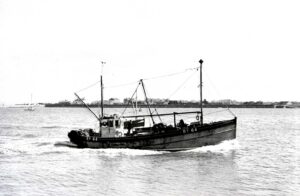
mfv Crystal Sea RY64
Picture courtesy of The Phil Rogers Collection
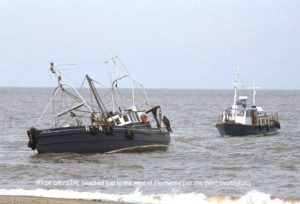
M.T. Crystal RY24
Picture courtesy of The John Worthington Collection
Changelog
07/12/2016: Page re-published due to site problems.
21/11/2019: Added an image.
06/10/2020: Added an image.

